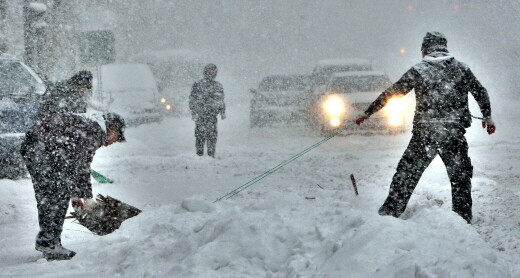hankyoreh
Links to other country sites 다른 나라 사이트 링크
Seoul hit by heaviest snowfall on record

On the first work day of the year, Monday, South Korea got hit with a blizzard of over 25 centimeters (cm) of snow. The blizzard was concentrated in the Seoul area, Incheon and Gyeonggi regions, and resulted in severe traffic congestion. The chaos was unprecedented, Gimpo Airport was virtually shut down for the first time in nine years and highways and ports experienced great difficulties.
The Korea Meteorological Administration (KMA) said the blizzard was so bad that the 25.8 cm of snow that had fallen in Seoul by 3:00 p.m. Monday represented the most snowfall it had seen since it began recording snowfall in 1907. The previous record of 25.6 cm occurred on Jan. 28, 1969. One KMA official said although records for new snowfall have only been kept since 1937, a look at past precipitation and snowfall records suggest the snowfall that fell in Seoul on Monday may be the most ever in 100 years since modern meteorological observations were collected in 1907. Other places in central South Korea also got hit hard with snowfall, including Incheon (22.3 cm), Suwon (19.5 cm), Munsan (20.2 cm) and Chuncheon (22.7 cm).
On the matter of heavy snowfall in Seoul and central South Korea, the KMA said large snow clouds resulted from continental cold air passing through Korea meeting warm moist air over the West Sea.
By the first morning rush hour of the new year, many Seoul residents were forced to give up driving and had to take the bus or subway to work instead. However, with roads closed and trains breaking down, some gave up going into work at all.
By 2:00 p.m. Monday, the snowfall had caused the closure of 43 roads throughout the country, while seven highway interchanges were blocked. In addition, the runways at Gimpo Airport were frozen over and as of Monday afternoon, 141 flights were canceled, the first in mass flight suspensions since January 2001.
The National Emergency Management Agency (NEMA) and regional Seoul, Incheon and Gyeonggi governments went into emergency mode as a result of the historic heavy snowfall, however, snow clearing operations were ineffective. Even the army lent a hand and deployed an estimated 5,000 men and 80 heavy vehicles, including snow ploys, Seoul’s Namtaeryeong, Cheongnyangni, Gangnam-gu, Deongneung and Mok-dong major transportation control areas.
Please direct questions or comments to [englishhani@hani.co.kr]
Editorial・opinion
![[Column] Park Geun-hye déjà vu in Yoon Suk-yeol [Column] Park Geun-hye déjà vu in Yoon Suk-yeol](https://flexible.img.hani.co.kr/flexible/normal/500/300/imgdb/original/2024/0424/651713945113788.jpg) [Column] Park Geun-hye déjà vu in Yoon Suk-yeol
[Column] Park Geun-hye déjà vu in Yoon Suk-yeol![[Editorial] New weight of N. Korea’s nuclear threats makes dialogue all the more urgent [Editorial] New weight of N. Korea’s nuclear threats makes dialogue all the more urgent](https://flexible.img.hani.co.kr/flexible/normal/500/300/imgdb/original/2024/0424/7317139454662664.jpg) [Editorial] New weight of N. Korea’s nuclear threats makes dialogue all the more urgent
[Editorial] New weight of N. Korea’s nuclear threats makes dialogue all the more urgent- [Guest essay] The real reason Korea’s new right wants to dub Rhee a founding father
- [Column] ‘Choson’: Is it time we start referring to N. Korea in its own terms?
- [Editorial] Japan’s rewriting of history with Korea has gone too far
- [Column] The president’s questionable capacity for dialogue
- [Column] Are chaebol firms just pizza pies for families to divvy up as they please?
- [Column] Has Korea, too, crossed the Rubicon on China?
- [Correspondent’s column] In Japan’s alliance with US, echoes of its past alliances with UK
- [Editorial] Does Yoon think the Korean public is wrong?
Most viewed articles
- 1‘We must say no’: Seoul defense chief on Korean, USFK involvement in hypothetical Taiwan crisis
- 2N. Korean delegation’s trip to Iran shows how Pyongyang is leveraging ties with Moscow
- 346% of cases of violence against women in Korea perpetrated by intimate partner, study finds
- 4[Column] Park Geun-hye déjà vu in Yoon Suk-yeol
- 5‘Weddingflation’ breaks the bank for Korean couples-to-be
- 6Will NewJeans end up collateral damage in internal feud at K-pop juggernaut Hybe?
- 7Amnesty notes ‘erosion’ of freedom of expression in Korea in annual human rights report
- 8[Interview] Dear Korean men, It’s OK to admit you’re not always strong
- 9Korean government’s compromise plan for medical reform swiftly rejected by doctors
- 10[Editorial] Japan’s rewriting of history with Korea has gone too far